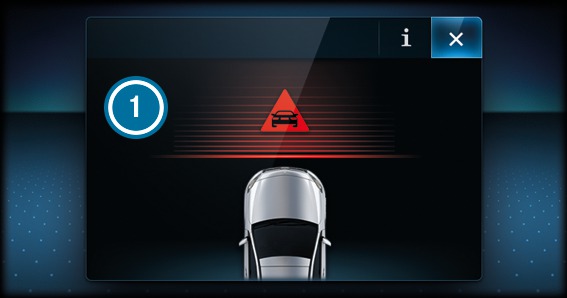Distance warning function
Autonomous braking function
Situation-dependent braking assistance
Vehicles with Driving Assistance Package: Evasive Steering Assist and cornering function
Active Brake Assist can help you to minimise the risk of a collision with vehicles, cyclists or pedestrians, or reduce the effects of such a collision.
If Active Brake Assist has detected a risk of collision, a warning tone sounds and the  distance warning lamp lights up in the instrument cluster.
distance warning lamp lights up in the instrument cluster.
If you do not react to the warning, autonomous braking can be initiated in critical situations.
In especially critical situations, Active Brake Assist can initiate autonomous braking directly. In this case, the warning lamp and warning tone occur simultaneously with the braking application.
If you apply the brake yourself in a critical situation or apply the brake during autonomous braking, situation-dependent braking assistance occurs. The brake pressure increases up to maximum full-stop braking if necessary.
Observe the notes on driving systems and your responsibility; you may otherwise fail to recognise dangers More.

If autonomous braking or situation-dependent braking assistance has occurred, display  appears in the multifunction display and then automatically goes out after a short time.
appears in the multifunction display and then automatically goes out after a short time.
Active Brake Assist cannot always clearly identify objects and complex traffic situations.
Also observe the system limits of Active Brake Assist.
From approximately 30 km/h, if over several seconds the distance maintained to the vehicle travelling in front is insufficient for the driven speed, the
 distance warning lamp lights up in the instrument cluster.
distance warning lamp lights up in the instrument cluster. From approximately 7 km/h, if your vehicle is critically close to a vehicle, cyclist or pedestrian, you will hear an intermittent warning tone and the
 distance warning lamp lights up in the instrument cluster.
distance warning lamp lights up in the instrument cluster.
Brake immediately or take evasive action, provided it is safe to do so and the traffic situation allows this.
at speeds up to approximately 250 km/h when approaching vehicles ahead
at speeds up to approximately 80 km/h when approaching stationary vehicles, moving pedestrians and cyclists ahead
at speeds up to approximately 60 km/h when approaching crossing cyclists
at speeds up to approximately 250 km/h when approaching vehicles ahead
at speeds up to approximately 100 km/h when approaching stationary vehicles
at speeds up to approximately 80 km/h when approaching moving pedestrians and cyclists ahead
at speeds up to approximately 70 km/h when approaching stationary pedestrians, crossing vehicles and stationary and crossing cyclists
at speeds up to approximately 200 km/h when approaching vehicles ahead
at speeds up to approximately 80 km/h when approaching cyclists ahead
at speeds up to approximately 60 km/h when approaching moving pedestrians and crossing cyclists
at speeds up to approximately 50 km/h when approaching stationary vehicles
at speeds up to approximately 250 km/h when approaching vehicles ahead
at speeds up to approximately 100 km/h when approaching stationary vehicles
at speeds up to approximately 80 km/h when approaching cyclists ahead
at speeds up to approximately 70 km/h when approaching stationary and moving pedestrians, crossing vehicles and stationary and crossing cyclists
at speeds up to approximately 250 km/h when approaching vehicles ahead
at speeds up to approximately 80 km/h when approaching stationary vehicles and vehicles ahead
at speeds up to approximately 60 km/h when approaching moving pedestrians and crossing cyclists
at speeds up to approximately 250 km/h when approaching vehicles ahead
at speeds up to approximately 100 km/h when approaching stationary vehicles
at speeds up to approximately 80 km/h when approaching cyclists ahead
at speeds up to approximately 60 km/h when approaching stationary and moving pedestrians, crossing vehicles and stationary and crossing cyclists
Activating kickdown.
Releasing the brake pedal.
You manoeuvre to avoid the obstacle.
There is no longer a risk of collision.
An obstacle is no longer detected in front of your vehicle.
The ability to detect stationary or moving pedestrians.
Assistance through power-assisted steering if it detects a swerving manoeuvre.
Activation by an abrupt steering movement during a swerving manoeuvre.
Assistance during swerving and straightening of the vehicle.
Reaction from a speed of approximately 20 km/h up to a speed of approximately 70 km/h.
You can prevent the assistance at any time by actively steering.
If a danger of collision from an oncoming vehicle is detected when turning across an oncoming lane, autonomous braking can be initiated at speeds below 15 km/h before you have left the lane in which you are driving.
Evasive Steering Assist cannot always recognise objects or complex traffic situations clearly.
Moreover, the steering support provided by Evasive Steering Assist is not sufficient to avoid a collision.
Full system performance is not available for a few seconds after switching on the ignition or after driving off.
In snow, rain, fog, heavy spray, if there is glare, in direct sunlight or in greatly varying light conditions.
If the sensors are dirty, misted up, damaged or covered.
If the sensors are impaired due to interference from other radar sources, e.g. strong radar reflections in multi-storey car parks.
If a loss of tyre pressure or a defective tyre has been detected and displayed.
If DSR is active.
In complex traffic situations where objects cannot always be clearly identified.
If pedestrians or vehicles move quickly into the sensor detection range.
If pedestrians are hidden by other objects.
If the typical outline of a pedestrian cannot be distinguished from the background.
If a pedestrian is not detected as such, e.g. due to special clothing or other objects.
On bends with a tight radius.
The Active Brake Assist sensors adjust automatically while a certain distance is being driven after the vehicle has been delivered. Active Brake Assist is unavailable or only partially available during this teach-in period.

